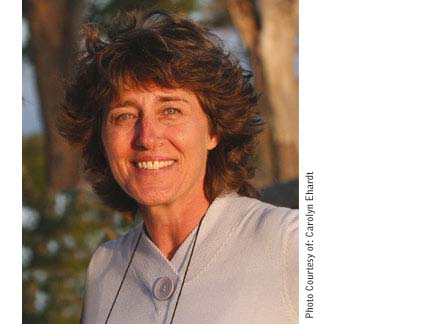


New Primate Found in Africa
by Judy Purdy
Intro
| No Luck Then a Jackpot
| Co-Discovery
| Demonstrating the Value of the Forests
| Nature of the Species

![]()
No Luck Then a Jackpot
In 2003, Ehardt was preparing for a yearlong ecological and population studies of Sanje mangabeys in the park and surrounding forests with support from the Wildlife Conservation Society, the Critical Ecosystem Partnership Fund and Primate Conservation, Inc.
She located a group of Sanje mangabeys for close-range studies and selected a volunteer field assistant, Trevor Jones, to help habituate them. The tall order required a year of patience plus mental and physical stamina to negotiate the rugged terrain. “You would try to follow them,” Ehardt said, “and of course they’re up in the trees and you’re on the ground, so they can go over a ridge and disappear. They’re also very skittish, as they were — and sometimes still are — hunted for food.”
In December 2004, the study group was habituated and systematic research began. Ehardt trained Jones and his Tanzanian assistants in her data-collection techniques, initiated the project and returned to Athens, Ga., to fulfill her spring-semester teaching assignment. She planned to rejoin her team in early May for the remainder of the study. In February, however, she learned of a cancerous lump, “an incredibly frustrating turn of events,” she said. Two surgeries and seven weeks of radiation treatment would keep her stateside until August at the earliest.

The delay put her in a bind to complete all aspects of her funded project. To speed things up she decided to send her team into Ndundulu Mountains Forest Reserve to try to locate groups of Sanje mangabeys that Danish ornithologist Lars Dinesen had spotted three times in the early 1990s. If any mangabeys remained in Ndundulu and if her team could locate them, the demographic data would be crucial to documenting the species’ conservation status. She emailed Jones to go to Dar-es-Salaam, Tanzania’s capital, and meet with Dinesen, who could pinpoint exactly where his team had spotted Sanje mangabeys.
Following the meeting, Jones and his assistants trekked to Dinesen’s mapped sites but never located the intended animals; instead, they caught glimpses of an unfamiliar species. In July, Jones emailed Ehardt, who was taking radiation treatment, with the surprising subject line: “New Mangabey for Tanzania?”
“I start reading this message, and Trevor writes, ‘Well, we saw something and all we know is that it wasn’t a Sanje mangabey. It was a monkey. I managed to get a very blurry picture, and I’ve attached it.’” Ehardt looked at the photograph and knew it was not a Sanje mangabey. “Not by a long shot,” she said. “I wasn’t so sure that it was any kind of monkey anybody had ever seen before — anywhere.”
The monkey seemed to have distinctive features much different from those of Sanje mangabeys or other known mangabeys, she said. The observed creatures had broad, upright crests of hair on their heads, white bellies and chests, and black faces. Ehardt described her reaction as “stunned, absolutely stunned.”
Jones also copied the email to primatologist Tom Butynski, Ehardt’s collaborator on the Udzungwa surveys and now director of Conservation International’s Eastern Africa Biodiversity Hotspots. “Tom looked at it and he and I began an email exchange on what it might be,” Ehardt said.
Intro
| No Luck Then a Jackpot
| Co-Discovery
| Demonstrating the Value of the Forests
| Nature of the Species
For comments or for information please e-mail: rcomm@uga.edu
To contact the webmaster please email: ovprweb@uga.edu
![]()